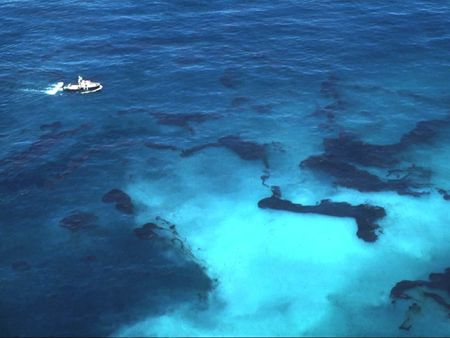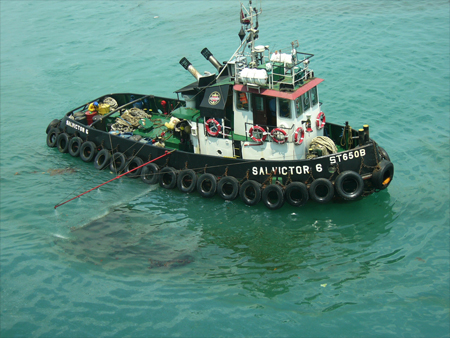Dispersants
When used appropriately, dispersants can be an effective oil spill response strategy. They are capable of quickly removing significant quantities of oil from the sea surface by transferring it into the water column where it is broken down by natural processes.
Significant environmental and economic benefits can be achieved, particularly when other at-sea response techniques are limited by weather conditions or the availability of resources. However, as with other response techniques, dispersants also have their limitations and account must be taken of the characteristics of the oil being treated, sea and weather conditions and environmental sensitivities.
How Chemical Dispersion Works
Natural dispersion of oil occurs when waves break a surface slick up into droplets that become suspended in the water column. The addition of dispersants is intended to accelerate this natural process.
Dispersants have two main components: a surfactant and a solvent. Surfactant molecules are made up of an oleophilic part (with an attraction to oil) and a hydrophilic part (with an attraction to water). The solvent transports and distributes the surfactants through an oil slick to the oil/water interface, where they reduce the surface tension and allow small oil droplets to break away from the slick. Although larger droplets may rise back to the surface, most will remain in suspension and will dilute and become degraded by naturally occurring bacteria.
Limitations
Dispersants have little effect on very viscous oils, as they tend to run off the oil into the water before the solvent can penetrate. They are also unsuitable for dealing with viscous emulsions (mousse) or oils which have a pour point near to or above that of the ambient temperature. Even those oils which can be dispersed initially become resistant after a period of time (usually a few hours to days) as weathering processes make the oil more viscous.
Monitoring Dispersant Effectiveness

It is essential that the effectiveness of chemical dispersion is monitored continually and dispersant use terminated as soon as it is no longer effective. Visual observation of effectiveness from a vessel or aerial platform is key but may be difficult in poor weather conditions, in waters with high sediment content, when dispersing pale-coloured oils, or in poor light. Effectiveness can also be monitored using Ultra-violet fluorimetry (UVF) to provide 'real-time' data on the concentration of dispersed oil in the water column. Ideally, it should be used in combination with visual observations to decide whether dispersant application is providing a worthwhile response.
Environmental Considerations
In many instances, a balanced assessment of the net environmental and economic benefits of using dispersants will be necessary in consultation with national authorities, prior to application. For example, in a given spill, the benefit gained by using dispersants to protect coastal amenities, sea birds and intertidal marine life may outweigh disadvantages such as the potential for temporary tainting of fish stocks. However, for another spill scenario, the potential impacts of dispersed oil on resources such as coral reefs, water intakes, or fish spawning areas might mean that dispersant application is inadvisable.
Dispersant use can be controversial, at times generating widespread debate in the media and public forums. Whilst its use can be viewed as a way of minimising the potential impacts of oil on sensitive resources, it is also sometimes seen as adding another unwanted pollutant into the environment that may prove toxic to marine fauna and flora.
The decision on whether or not to use dispersants is seldom clear-cut and a balance has to be struck between the advantages and limitations of the different available response options, conflicting priorities for protecting different resources from pollution damage and cost-effectiveness. Detailed contingency planning will aid in this decision process.
Methods of Application

Dispersants can be applied by a variety of methods. In general, spraying dispersant from vessels and small aircraft or helicopters is more suitable for treating smaller spills and nearshore areas. Large multi-engine planes are best equipped for handling large offshore spills. The key to successful chemical dispersion is the ability to target the thickest part of the oil slick in a timely manner, before weathering means dispersants are no longer effective.
Read more
Vessel Spraying
Dispersants are applied from boats that are usually equipped with specialised spray arms. If spray arms are not available, fire hoses or monitors are sometimes used to apply diluted concentrate dispersants. However, the very high flow rate makes it difficult to achieve optimum dilution of the dispersant and uniform application of the dispersant difficult.
Vessels offer certain advantages for dispersant spraying. They are usually readily available and are easy to load and deploy. They have cost advantages over aircraft and can apply dispersant fairly accurately to specific areas of a slick. However, vessels also have serious limitations, particularly for larger spills. The area of oil that can be treated and the rate of dispersant application are both relatively low in comparison to larger aircraft, and it can be difficult to locate the heaviest concentrations of oil from the bridge of a vessel.
Aerial Spraying
Aerial dispersant application offers significant advantages over vessels. Aircraft allow a rapid response, good visibility, high treatment rates and optimum dispersant use. In addition, aircraft can be used to treat spills further offshore.
Dispersant can be applied from specially designed aircraft, or from agricultural or pest control spray planes which require minor modification. Several types of helicopter have also been adapted to spray dispersants, and most are able to carry underslung bucket spray systems without modification. Aircraft selection will depend on the size and location of the spill, although in reality local availability will often be the crucial factor. The endurance, fuel consumption, turnaround time, payload and ability to operate from short or improvised landing strips are all important factors to consider.
Shoreline Application
Once bulk oil has been removed from affected shorelines, dispersants are sometimes used as cleaning agents during the final stages of clean-up to remove the remaining oil from hard surfaces such as rocks, sea walls, and other man-made structures. The dispersed oil cannot be collected, and for this reason, dispersant use on the shoreline is restricted to areas of low environmental concern but high amenity value. Shoreline cleaners, specifically formulated for the task, may often provide a better alternative.
